Salamanca
| Salamanca | |||
|---|---|---|---|
|
View of Salamanca | |||
| |||
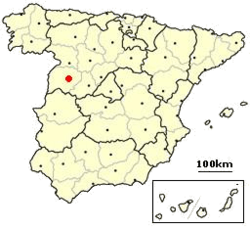 Location of Salamanca in Spain | |||
| Coordinates: 40°58′N 5°40′W / 40.967°N 5.667°W | |||
| Country | Spain | ||
| Autonomous community | Castile and León | ||
| Province | Salamanca | ||
| Government | |||
| • Mayor | Alfonso Fernando Fernández Mañueco (Partido Popular) | ||
| Area | |||
| • Total | 38.6 km2 (14.9 sq mi) | ||
| Elevation | 802 m (2,631 ft) | ||
| Population (2010) | |||
| • Total | metropolitan:213,399 city:154,462 | ||
| • Density | 4,034/km2 (10,450/sq mi) | ||
| Time zone | CET (UTC+1) | ||
| • Summer (DST) | CEST (UTC+2) | ||
| Area code(s) | 34 (Spain) + 923 (Salamanca) | ||
| Website | www.salamanca.es | ||
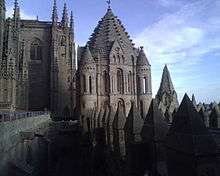
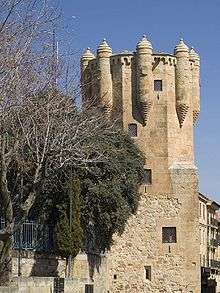
Salamanca (Spanish pronunciation: [salaˈmaŋka]) is an ancient Celtic city in northwestern Spain that is the capital of the Province of Salamanca in the community of Castile and León. The city lies on several hills by the Tormes River. Its Old City was declared a UNESCO World Heritage Site in 1988. With a metropolitan population of 228,881 in 2012 according to the National Institute of Statistics (INE), Salamanca is the second most populated urban area in Castile and León, after Valladolid (414,000), and ahead of Leon (187,000) and Burgos (176,000).
It is one of the most important university cities in Spain and supplies 16% of Spain's market for the teaching of the Spanish language.[1][2] Salamanca attracts thousands of international students,[3] generating a diverse environment.
It is situated approximately 200 kilometres (120 miles) west of the Spanish capital Madrid and 80 km (50 mi) east of the Portuguese border. The University of Salamanca, which was founded in 1218, is the oldest university in Spain and the fourth oldest western university, but the first to be given its status by the Pope Alexander IV who gave universal validity to its degrees. With its 30,000 students, the university is, together with tourism, a primary source of income in Salamanca.
History
The city was founded in the pre-Ancient Rome period by the Vaccaei, a Celtic tribe, or the Vettones, a Celtic or pre-Celtic indo-European tribe, as one of a pair of forts to defend their territory near the Duero river. In the 3rd century BC, Hannibal laid siege to the city. With the fall of the Carthaginians to the Romans, the city of Helmantica, as it was known, began to take more importance as a commercial hub in the Roman Hispania due to its favorable location. Salamanca lay on a Roman road, known as the Vía de la Plata, which connected it with Emerita Augusta (present day Mérida) to the south and Asturica Augusta (present-day Astorga) to the north. Its Roman bridge dates from the 1st century, and was a part of this road.
With the fall of the Roman Empire, the Alans established in Lusitania, and Salamanca was part of this region. Later the city was conquered by the Visigoths and included in their territory. The city was already an episcopal see, and signatures of bishops of Salamanca are found in the Councils of Toledo.
Salamanca surrendered to the Moors, led by Musa bin Nusair, in the year 712 AD. For years, this area between the south of Duero River and the north of Tormes River, became the main battlefield between the Christian kingdoms and the Muslim Al-Andalus rulers. The constant fighting of the Kingdom of León first, and the Kingdom of Castile and León later against the Caliphate depopulated Salamanca and reduced it to an unimportant settlement. After the battle of Simancas (939) the Christians resettled this area. After the capture of Toledo by Alfonso VI of León and Castile in 1085, the definitive resettlement of the city took place. Raymond of Burgundy, instructed by his father-in-law Alfonso VI of León, led a group of settlers of various origins in 1102.
One of the most important moments in Salamanca's history was the year 1218, when Alfonso IX of León granted a royal charter to the University of Salamanca, although formal teaching had existed at least since 1130. Soon it became one of the most significant and prestigious academic centres in Europe.
During the 16th century, the city reached its height of splendour (around 6,500 students and a total population of 24,000). During that period, the University of Salamanca hosted the most important intellectuals of the time; these groups of mostly-Dominican scholars were designated the School of Salamanca. The juridical doctrine of the School of Salamanca represented the end of medieval concepts of law, and founded the fundamental body of the ulterior European law and morality concepts, including rights as a corporeal being (right to life), economic rights (right to own property) and spiritual rights (rights to freedom of thought and rights related to intrinsic human dignity).
In 1551, the Holy Roman Emperor Charles V ordered an inquiry to find out if the science of Andreas Vesalius, physician and anatomist, was in line with Catholic doctrine. Vesalius came to Salamanca that same year to appear before the board and was acquitted.
Salamanca suffered the general downturns of the Kingdom of Castile during the 17th century, but in the 18th century it experienced a rebirth. In this period, the new baroque Cathedral and main square (Plaza Mayor) were finished.
In the Peninsular War of the Napoleonic campaigns, the Battle of Salamanca, fought on July 22, 1812, was a serious setback for the French, and a mighty setback for Salamanca, whose western quarter was seriously damaged. The battle which raged that day is famous as a defining moment in military history; many thousands of men were slaughtered by cannon fire in the space of only a few short hours.
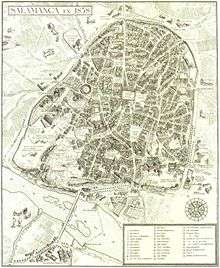
During the devastating Spanish Civil War (1936–39) the city quickly went over to the Nationalist side and was used as the de facto capital. Franco was named Generalissimo on 21 September 1937 while at the city, and in the same year was formed, by a decree signed in the city, the official fascist party that ruled Spain until the end of the Francoist regime, officially suppressing any other political party. The Nationalists soon moved most of the administrative departments to Burgos, which being more central was better suited for this purpose. However, some administrative departments, Franco's headquarters (located at the Palacio Episcopal, next to the Old Cathedral) and the military commands stayed in Salamanca, along with the German and Italian fascist delegations, making it the de facto Nationalist capital and centre of power during the entire civil war.[4][5] Like much of fervently Catholic and largely rural Leon and Old Castile regions, Salamanca was a staunch supporter of the Nationalist side and Francisco Franco's regime for its long duration.
In 1988, the old city was declared a UNESCO World Heritage Site. In 1998, it was declared a European Capital of Culture for year 2002 (shared with Bruges). During 14 and 15 October 2005, it hosted the XV the Ibero-American Summits of Heads of State and Governments.
Since 1996, Salamanca has been the designated site of the archives of the Spanish Civil War (Archivo General de la Guerra Civil Española). The original documents were assembled by the Francoist regime, selectively obtained from the administrative departments of various institutions and organizations during the Spanish Civil War as a repressive instrument used against opposition groups and individuals.[6] The socialist government moved the Catalan part of the archive to Barcelona in 2006 despite opposition from the local authorities and popular protests.
Main sights
The Old City of Salamanca was declared a World Heritage Site by UNESCO in 1988.
| Name | Location |
|---|---|
| Old quarter of the city | |
| Irish College | c/ Fonseca, 2 |
| Iglesia de San Marcos | c/ Zamora - Plaza del Ejército |
| Iglesia de Sancti Spiritus | Sancti Spiritus, 34 |
| Convento de las Claras | c/ de Santa Clara, 2 y 12; c/ del Lucero 2 y 18 |
| Casa-Convento de Santa Teresa | c/ Crespo Rascón, 19 |
| Iglesia de San Juan de Barbalos | Pl. San Juan Bautista, 2 - c/ Luis Sevillano, 2 |
| Iglesia de San Cristobal | Plaza de San Cristobal, 8 |
Sightseeing in the city, many of them within the old quarter,[7] are:
Squares and public spaces
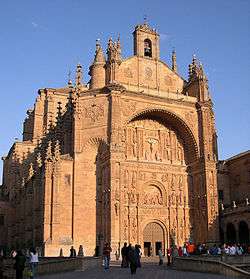

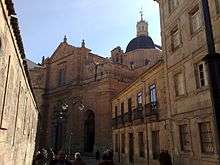
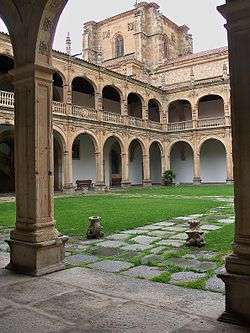

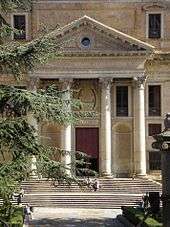

.jpg)
- La Plaza Mayor: of Baroque style, designed by architects Alberto and Nicolás Churriguera is the most important of public spaces and the heart of the city.
- Campo de San Francisco (Salamanca): First public garden in the city on grounds of the former convent of San Francisco Real.
- Huerto de Calisto y Melibea (Salamanca): Garden near the cathedrals where, some say, lies the plot of the novel La Celestina by Fernando de Rojas. Beside it are remains of the Roman Walls.
- Plaza del Corrillo (Salamanca): Small square adjacent to the Plaza Mayor. On the left is the Romanesque church of San Martín and the right a series of houses with porches formed by columns of stone completed in pads representing the days of the week (a moon for the Monday, a Mars for Tuesday, etc.).
Religious buildings
- Capilla de la Vera Cruz: Baroque church with Renaissance façade, headquarters of the five-hundred-year-old Brotherhood of the Vera Cruz of Salamanca. It houses countless works of art.
- Cathedrals: Salamanca has two cathedrals, the Old Cathedral, of the 12th century and of Romanesque style, and the New Cathedral, much larger, built in the 16th century of Gothic style and completed in the 18th century. The place where they both join is known as Patio Chico and is one of the most charming corners of the city.
- La Clerecía: currently houses the Pontifical University. Building started in 1617 and was completed 150 years later as the Colegio Real del Espíritu Santo, of the Society of Jesus. The style is Baroque. It difference the school, with an interesting cloister and the church, with an impressive façade of three bodies, two twin towers of 50 meters high and a huge dome. The Clerecía name is because it belonged to the Real Clerecía de San Marcos after the expulsion of the Jesuits.
- Colegio de Calatrava: Built in the 18th century, by the initiative of the Order of Calatrava, now houses the Casa de la Iglesia.
- Convento de las Agustinas e Iglesia de la Purísima: In the church is a painting of the Immaculate Conception painted by Jusepe de Ribera. It is the only construction of totally Italian space and decor in Spain.
- Convento de las Dueñas (15th century): Highlights the irregular Renaissance cloister.
- Convento de las Isabeles (Salamanca)
- Convento de San Antonio el Real (1736): of Baroque style, its remains were divided between the Lyceum Theatre and a store where it can visit.
- Convento de San Esteban, of the Dominican friars (16th century): the plateresque façade, with its shape of an arc of triumph, is a jewel of the Salamancan Renaissance. Impressive Baroque altarpiece by José Benito Churriguera. Also noteworthy is the Cloister of the Kings, Renaissance.
- Convento de la Anunciación (Calle de las Úrsulas): Founded by the Archbishop Alonso II de Fonseca in 1512. Stresses the exterior apse of Gothic style. In the inside, the Baroque altarpiece and the tomb of the founder, Renaissance, work by Beto.
- Convento de la Trinidad: Former Palacio de Montellano adapted in the 16th century to host a Trinitarian friary.
- Monasterio de Nuestra Señora de la Victoria, of the monks of the Order of St. Jerome, completed in 1513, almost destroyed by the French in the early 19th century, the Peninsular War, is now integrated into the manufacturing facilities of the 19th century, of the Grupo Mirat.
- Ermita de Nuestra Señora de la Misericordia (16th-17th centuries): small Baroque chapel which was begun in 1389 in the Plaza de San Cristobal. Currently very damaged, is a printing, while its bell-gable decorates the church of the Pizarrales neighborhood.
- Antigua Iglesia de las Bernardas work by Rodrigo Gil de Hontañón. Prototype of the Salamancan churches of the 16th century. Stresses the shell-shaped head. Today it is within the Colegio de San José de Calasanz.
- Iglesia del Carmen de Abajo: Chapel of the Third Order Carmelites, incorporated in the Friary of San Andrés. It is the only remnant of that friary, which disappeared in the 19th century.
- Iglesia de San Benito: Gothic church built under the patronage of Alonso II de Fonseca, pantheon of the Maldonado family.
- Iglesia de San Julián: Romanesque church subsequently restored.
- Iglesia de San Marcos: Romanesque church near the path which ran the North walls of the city. Outside circular plant has three naves and apses inside.
- Iglesia de San Martín: Romanesque church with Gothic reforms, Renaissance and Baroque, attached to the Plaza Mayor.
- Iglesia de San Pablo: Baroque church belonging to the former convent of the Trinitarians, houses the image of Jesus Rescued, much venerated in the city. Parish hosts, governed by the Diocesan Laborer Priests.
- Iglesia de Santo Tomás Cantuariense: Romanesque church founded in honor of St. Thomas, Archbishop of Canterbury in 1175, just five years after his death and two after his canonization. It has three apses and a nave with a wooden roof. Form Parish along with St. Paul, governed by the Diocesan Laborer Priests.
University buildings
- University: Set of buildings that made up the former University of Salamanca, including the Escuelas Mayores, the Escuelas Menores and the Hospital de Estudio (current rectorate). These buildings are situated around the square known as Patio de Escuelas. In this same square is the home of Dr. Álvarez Abarca or of the Doctors of the Queen (15th century), whose façade is Gothic with Renaissance details and is now the Museum of Salamanca.
- Casa-museo de Unamuno (18th century): former home of the rectors of the university. It preserved as in its time it had Miguel de Unamuno when he took this position.
- Colegio Mayor de Santiago el Zebedeo, also called "of the Archbishop Fonseca" or "of the Irish" (16th century).
- Colegio de San Ambrosio (1719): Is currently General Archive of the Spanish Civil War. Houses documents and items seized by the national troops and their allies during and at the end of the Spanish Civil War. While over the entire postwar its basic objective was to preserve the information related to organizations and peoples potentially opposing the Franco regime, and therefore use this information for repressive, since the return of democracy this building would become one of the most important archives that existed in Spain to investigate the historical period of the Second Republic. Many of the documents and objects that still remain in the archive are related to the Freemasonry, including several furniture that has been rebuilt a Masonic Lodge.
- Colegio Trilingüe: founded in 1554 to the teaching of Latin, Greek and Hebrew. It also preserves part of the original courtyard, remade in 1829, in the Faculty of Physics.
- Palacio de Anaya was the last headquarters of the Colegio Mayor de San Bartolomé or Colegio de Anaya founded in the 15th century by Don Diego de Anaya, abolished in the early 19th century. Today is the faculty of philology. Next to the building is the Iglesia of San Sebastian, former chapel of the college and the Inn, work by Joaquín de Churriguera.
- Colegio Santa Cruz de Cañizares (16th century): Music Conservatory. Of it only remains the old chapel, now incorporated into the assembly hall of the conservatory, and the main façade, of plateresque style.
- Colegio de San Pelayo: founded in the mid-16th century. Since 1990 home to the Faculty of Geography and History.
Palaces and palatial houses
- Casa de las Conchas: built in the late 15th century. of Gothic civil style, its façade is decorated with about 350 shells of scallops, distinctive of the Order of Santiago. Also important are the bars Gothic windows. It currently houses a public library.
- Casa de Don Diego Maldonado: 16th-century Plateresque palace. It houses the Hispanic-Brazilian Cultural Foundation and the Centre for Brazilian Studies at the University of Salamanca.
- Casa de Doña María la Brava: 15th-century Gothic building, prototype of the noble mansions of the time. Its owner, María Rodríguez de Monroy was the head of one of the two sides in that split the city in the 15th century. Beheaded the murderers of her children. It is located in the Plaza de los Bandos.
- Casa Lis: Art Nouveau palace of 1905 with iron façade. Built on the walls. It houses the Collections of Art Nouveau and Art Deco donated by Manuel Ramos Andrade.
- Casa de las Muertes (early 16th century), built by Juan de Álava and named such for the skulls that decorate the façade.
- Casa del Regidor Ovalle (18th century): The Spanish writer Miguel de Unamuno died here.
- Casa de Santa Teresa (16th century): The saint Teresa of Ávila stayed here when she visited Salamanca in 1570 to found a convent and here she wrote the poem Vivo sin vivir en mí.
- Casa de la Tierra (15th century): doorway with arched, Gothic window tracery. Headquarters of the Chamber of Commerce and Industry of Salamanca.
- Casa de las Viejas (17th century): old workhouse for poor, now the headquarters of the Regional Film Archive of Castile and León. Permanent exhibition of equipment related to cinema and its history, owned by Salamancan filmmaker Basilio Martín Patino.
- Fonda Veracruz : courtyard with wooden galleries in form of dead-end street. Currently catering school.
- Arias Corvelle Palace (15th century): sgraffito façade very similar to that of San Boal. It houses the School of Fine and Performing Arts of San Eloy.
- Castellanos Palace (15th-16th centuries): The Palace of the Marquises of Castellanos construction began in the late 15th century, although the façade dates from the late 19th century which combines Gothic and Neoclassical styles. With a powerful Gothic interior courtyard, this building now serves as a hotel.
- Garci Grande Palace (16th century): Renaissance doorway and chamfered corner windows unique in the city. Head Office of the Savings Bank (Caja Duero).
- Monterrey Palace: was built in the 16th century and is of plateresque style. Belongs to the House of Alba and highlight its towers and chimneys. Only it built one of the four parts that composed all designed initially.
- Orellana Palace (16th century): building of classical architecture with Mannerist influence. The courtyard in L shape and the ladder.
- Rodríguez de Figueroa Palace (1545): has interesting façades at the streets Concejo and Zamora and interior courtyard. Today the Salamanca Casino.
- La Salina Palace (1546): Renaissance, work by Rodrigo Gil de Hontañón. Since 1884 is the headquarters of the Provincial Diputation.
- San Boal Palace (15th century): façade decorated with sgraffitos. Was School of Commerce and later Faculty of Business. Since 1999 is Hispanic-Japanese Cultural Center of the University of Salamanca. In the same square is the Iglesia de San Boal (17th century).
- Solís Palace (15th century): In this palace were married Philip II of Spain and Maria Manuela of Portugal in 1543. Today it houses the Telefónica.
- Tower del Aire: is all that remains of the Palace of the dukes of Fermoselle, built in the 15th century. It has beautiful Gothic windows. It is currently a student residence.
- Tower del Clavero (15th century): remains of a palace, apparently built by Francisco de Sotomayor, Clavero Staff of the Order of Alcántara, about 1470 . The lower part is quadrangular, while the upper is octagonal adorned with eight cylindrical turrets.
- Torreón de los Anaya (15th century): old manor house of Gothic civil style which highlights the mullioned window and the Patio de Tres Lados. For years it was the seat of Institute of Studies of Latin America and Portugal of the University of Salamanca, also known as Palacio de Abrantes.
Museums
- Casa Lis Art Nouveau and Art Deco Museum. The museum displays collections of the work of Émile Gallé, Demetre Chiparus and other artists of the Art nouveau and Art Deco period, in addition to special exhibitions.
- Museum of the History of the City
- Museum of Trade of Salamanca
- Casa Museo Unamuno
- Museum of Automotive History of Salamanca
- Museum of Salamanca
- Cathedral Museum
- Museum of the Convento de San Esteban
- University Museum - University Library
- University Collections
- Bullfighting Museum
- Collections of the Convento de las Úrsulas
- Museum of the Convento de Santa Clara
- Teresian Museum
- Casa Museo de Zacarías González. House where Zacarías González lived and painted, on the street Alarcón.
- Permanent Exhibition IERONIMUS. The name of the exhibition: IERONIMUS alludes to Don Jerónimo de Périgueux, famed French-born Spanish bishop by the Diocese of Salamanca in 1102, who commissioned the construction of the Iglesia de Santa María. This was the event that marked the origin of the 900 Years of Art and History of the Cathedrals of Salamanca. In this tour one can admire amazing places like the one offered by the gazebo next to the Tower del Gallo, the Patio Chico or the Terraza de Anaya. The circuit of the exhibition begins in the Board of Warden, continuing on the Board of the Tower Mocha, the Platform of the Superior Room and the Board of Vault.
It is accessed from the last tower, next to the gate of Santa Lucía (giving access to the old cathedral). In three of the rooms one can find exposed drawings, documents and religious objects related to the cathedrals; especially with its construction, one can see, both inside and outside the two cathedrals. From the "Sala del Alcaide" enjoy a splendid view of the nave and the altar of the old cathedral, and from the upper platform located thereupon, one may accurately observe the Tower del Gallo, as well as views of the Tormes and Transtormes neighborhoods. One may also enjoy the vaults of the new cathedral, and again on the outside with views of the plaza Anaya, the Tower del Reloj, the Rua Mayor and all of the historical centre.
Others
- Theatre Bretón. Now destroyed.
- Cave of Salamanca. Located on the Carvajal slope, where it is said that the devil taught black magic.
- Central Market (1899–1909). Located in the old Plaza de la Verdura. Made of iron.
- Roman Bridge of Salamanca. Crossing the Tormes River, it is 150 m long and built on 26 arches, of which fifteen are Roman of the 1st century BC, while the remainder date from a 16th-century reconstruction after a flood.
Nearby are the Mudéjar Romanesque church of Santiago (modern reconstruction) and the stone bull quoted in Lazarillo de Tormes.
University
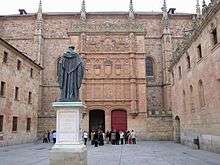
The University of Salamanca was founded in 1134 and in 1218 it was given the royal charter of foundation ("Estudio General") by Alfonso IX of León. It was the first university to receive the title of "University" in 1254. Under the patronage of the learned Alfonso X, its wealth and reputation greatly increased (1252–1282), and its schools of canon law and civil law attracted students even from the Universities of Paris and Bologna. In the 16th century, the city's fortunes depended on those of the University. About the time Christopher Columbus was lecturing there on his discoveries, Hernán Cortés took classes at Salamanca, but returned home in 1501 at age 17, without completing his course of study. (About ten years later the conquistador Francisco Vásquez de Coronado was born in Salamanca.)
Climate
Salamanca has a cold semi-arid climate (BSk), bordering on a warm-summer Mediterranean climate (Csb) according to the Köppen climate classification, with cool winters, and warm dry summers due to the altitude.
| Climate data for Salamanca Airport 790m (1981-2010) | |||||||||||||
|---|---|---|---|---|---|---|---|---|---|---|---|---|---|
| Month | Jan | Feb | Mar | Apr | May | Jun | Jul | Aug | Sep | Oct | Nov | Dec | Year |
| Record high °C (°F) | 19.8 (67.6) |
25.0 (77) |
25.8 (78.4) |
31.0 (87.8) |
34.5 (94.1) |
38.6 (101.5) |
39.8 (103.6) |
41.0 (105.8) |
39.0 (102.2) |
30.7 (87.3) |
24.8 (76.6) |
19.7 (67.5) |
41 (105.8) |
| Average high °C (°F) | 8.6 (47.5) |
11.2 (52.2) |
14.9 (58.8) |
16.5 (61.7) |
20.6 (69.1) |
26.6 (79.9) |
30.0 (86) |
29.5 (85.1) |
25.1 (77.2) |
18.9 (66) |
12.8 (55) |
9.4 (48.9) |
18.7 (65.7) |
| Daily mean °C (°F) | 4.0 (39.2) |
5.5 (41.9) |
8.3 (46.9) |
10.1 (50.2) |
14.0 (57.2) |
18.8 (65.8) |
21.5 (70.7) |
21.1 (70) |
17.6 (63.7) |
12.6 (54.7) |
7.9 (46.2) |
4.9 (40.8) |
12.2 (54) |
| Average low °C (°F) | −0.7 (30.7) |
−0.2 (31.6) |
1.7 (35.1) |
3.8 (38.8) |
7.3 (45.1) |
11.0 (51.8) |
12.9 (55.2) |
12.6 (54.7) |
10.0 (50) |
6.4 (43.5) |
2.4 (36.3) |
0.4 (32.7) |
5.6 (42.1) |
| Record low °C (°F) | −15.6 (3.9) |
−20.0 (−4) |
−9.0 (15.8) |
−5.5 (22.1) |
−2.3 (27.9) |
2.0 (35.6) |
5.0 (41) |
4.5 (40.1) |
0.4 (32.7) |
−4.7 (23.5) |
−10.6 (12.9) |
−12.0 (10.4) |
−20 (−4) |
| Average precipitation mm (inches) | 30 (1.18) |
25 (0.98) |
21 (0.83) |
38 (1.5) |
47 (1.85) |
29 (1.14) |
11 (0.43) |
12 (0.47) |
32 (1.26) |
46 (1.81) |
40 (1.57) |
42 (1.65) |
372 (14.65) |
| Average precipitation days | 6 | 5 | 5 | 7 | 8 | 4 | 2 | 2 | 4 | 7 | 7 | 7 | 64 |
| Average snowy days | 2 | 2 | 1 | 1 | 0 | 0 | 0 | 0 | 0 | 0 | 1 | 1 | 7 |
| Average relative humidity (%) | 82 | 73 | 63 | 62 | 59 | 52 | 47 | 51 | 59 | 71 | 79 | 83 | 65 |
| Mean monthly sunshine hours | 118 | 154 | 211 | 224 | 265 | 317 | 358 | 330 | 251 | 183 | 130 | 104 | 2,667 |
| Source: Agencia Española de Meteorología (1981-2010 climatology)[8] | |||||||||||||
Economy
The city's economy is dominated by the university and tourism, but other sectors including agriculture and livestock rearing along with construction and manufacturing are also significant. Not surprisingly, in December 2007 83% of the working population, equivalent to 55,838, were employed in the service sector.[9]
Industry
Industrial activity accounted for 5% of the working population, or 3,340 workers employed over 360 businesses.[9] Two of the largest businesses, both of them numbered among the largest 100 enterprises in the region, are the veterinary vaccine manufacturer "Laboratorios Intervet", and the fertilizer specialist manufacturers S.A. Mirat, which is the city's oldest industrial company, having been established originally as a starch factory in 1812.[10]
Communications
Road
Highways
- A50: Autovía de la Cultura: Ávila - Salamanca
- A62: Autovía de Castilla: Burgos - Valladolid - Salamanca - Ciudad Rodrigo.
- A66: Autovía Ruta de la Plata: Gijón - Oviedo - Mieres - Puerto de Pajares - León - Benavente - Zamora - Salamanca - Béjar - Plasencia - Mérida - Sevilla.
- SA-11: North access to Salamanca.
- SA-20: South access to Salamanca.
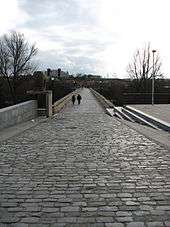
Other roads
- N-501: Ávila - Peñaranda de Bracamonte - Salamanca.
- N-620: Burgos - Venta de Baños - Valladolid - Tordesillas - Salamanca - Ciudad Rodrigo - Portugal.
Airport
Salamanca Airport, located in the military base of Matacán, is located about 14 km (9 mi) east of the city.
Public transport
There are 13 bus lines during the day and two night lines. Also, a tram line has been projected.[11]
Culture and sports
| Old City of Salamanca | |
|---|---|
| Name as inscribed on the World Heritage List | |
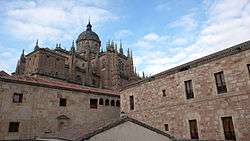 | |
| Type | Cultural |
| Criteria | i, ii, iv |
| Reference | 381 |
| UNESCO region | Europe and North America |
| Inscription history | |
| Inscription | 1988 (12th Session) |
The Old City of Salamanca was declared a UNESCO World Heritage Site in 1988. In 2002 Salamanca shared the title of European Capital of Culture with Bruges. In 2005, Salamanca celebrated the 250 anniversary of the construction of the Plaza Mayor with a number of European events (Plaza Mayor de Europa).
Festivals

Holy Week
The Holy Week in Salamanca (Semana Santa) is the most well-known of Salamanca's festivals. Salamanca is renowned for the solemn and sober processions celebrated during Holy Week. 16 confraternities, 10.000 brothers or "cofrades", 50 floats or "pasos" celebrate the Passion of Christ with 20 processions and thousands of followers, tourist and visitors.
Some of the celebrations have been performed for centuries. The confraternities carry artistic pasos created by important Spanish artists such as Luis Salvador Carmona, Alejandro Carnicero or Mariano Benlliure. in 2003 the Semana Santa of Salamanca obtained the official declaration of International Touristic Interest.[12]
Other
Salamanca is also famous throughout Spain and the rest of Europe for its celebrations of "Nochevieja Universitaria," loosely translated as "University New Year".[13] It is usually held on the Thursday of the last week of school in December and two weeks before the real New Year's Eve. On this day, students congregate in the Plaza Mayor, Salamanca to watch free performances and take part in the countdown to midnight.
Sports
Salamanca offers the amenities of a larger city while retaining an intimate small town atmosphere. Since 1923, "Los Charros", formally the Union Deportiva Salamanca, have been the Salamanca football team. In 2013, the club went bankrupt and its activities were abandoned.[14]
Teams based in Salamanca
- CF Salmantino, football team. (Tercera División league)
- Unionistas de Salamanca CF, football team. (Primera Regional league)
- Salamanca AC, football team. (Segunda División B league)
- CB Avenida, basketball team. (Liga Femenina de Baloncesto,)
Cinema
Salamanca has been shown in the cinema many times. Its old streets are the perfect setting for historic productions. Among some international films should be mentioned 1492: Conquest of Paradise by Ridley Scott and Goya's Ghosts by Miloš Forman. Salamanca was the setting for the 2008 political thriller Vantage Point, although the movie was almost exclusively filmed in Mexico.
Gastronomy
Salamanca has a very interesting and distinctive gastronomy. Among many dishes, Chanfaina (steamed rice with pork) is very popular. Another classic dish of the Salamancan, known as Charreria ("peasant lands"), is a cocido, a slow-cooked casserole including chickpeas. However, Hornazo, a meat pie, is the most popular dish of all.
Gallery
 Plateresque façade of the University of Salamanca
Plateresque façade of the University of Salamanca Salamanca viewed from the Old Cathedral
Salamanca viewed from the Old Cathedral- New Cathedral of Salamanca
 Plaza Mayor
Plaza Mayor Casa de las Muertes (House of the Deaths)
Casa de las Muertes (House of the Deaths)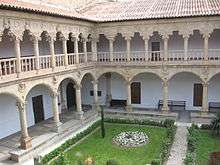 Cloister of Convento de las Dueñas
Cloister of Convento de las Dueñas- Banco de España
 Walls of Salamanca
Walls of Salamanca The Roman bridge of Salamanca
The Roman bridge of Salamanca Statue of D. Gonzalo Torrente Ballester located at the literary café: Café Novelty. The oldest of the cafes of Salamanca, which opened in 1905 in the Plaza Mayor of Salamanca.
Statue of D. Gonzalo Torrente Ballester located at the literary café: Café Novelty. The oldest of the cafes of Salamanca, which opened in 1905 in the Plaza Mayor of Salamanca. A statue of Jesus in Salamanca
A statue of Jesus in Salamanca
Notable people
- Fernando Gallego (1440-1507), Spanish painter
- José María Gil-Robles (1898–1980), politician
- Vicente del Bosque (born 1950), Spanish soccer coach, with the national team world champion in 2010
- Jose Ignacio Sanchez Galan (born 1950), Spanish engineer and manager
- Yann Martel (born 1963), Canadian writer
- Óscar González Marcos (born 1982), Spanish professional footballer
- Álvaro Arbeloa (born 1983), Spanish professional footballer
- Eleuterio Sánchez (born 1942), former Spanish thief, today lawyer
See also
References
- ↑ "Noticias - Salamanca: enseñanza de español mueve 46 millones de euros". El Castellano. Retrieved 2011-08-17.
- ↑ http://www.espanolensalamanca.com Spanish in Salamanca
- ↑ "La USAL inaugura los cursos de verano con 2.000 estudiantes extranjeros". elmundo.es. Retrieved 2011-08-17.
- ↑ Hugh Thomas, pág. 550
- ↑ Hugh Thomas, pág. 650
- ↑ Patrimoni digita
- ↑ "18 Cosas que hacer gratis en Salamanca cuando no tienes un duro" (in Spanish). conciertosensalamanca.com. Retrieved 2015-01-14.
- ↑ "Monthly Averages for Salamanca, Spain". Agencia Española de Meteorología. Retrieved 2009-10-20.
- 1 2 "Salamanca - Datos Económicos y Sociales" (PDF). cajaespana.es. 2009. Retrieved 2011-08-17.
- ↑ "MIRAT Historia Antecedentes". mirat.net. Retrieved 2011-08-17.
- ↑ EUROPA PRESS. 09.06.2008 (2008-05-16). "Presentan un estudio de viabilidad para la implantación del tranvía en Salamanca". 20minutos.es. Retrieved 2011-08-17.
- ↑ Easter | Salamanca. Salamanca.es. Retrieved on 2013-09-05.
- ↑ University New Year
- ↑ La RFEF desciende a la UDS por las deudas con los futbolistas - UDS -Noticias de La Gaceta de Salamanca. Lagacetadesalamanca.es (2013-06-29). Retrieved on 2013-09-05.
External links
| Wikimedia Commons has media related to Salamanca. |
| Wikivoyage has a travel guide for Salamanca. |
| Wikisource has the text of The New Student's Reference Work article Salamanca. |
- Official Tourist Information Office
- Wiki of the city of Salamanca
- General information on Salamanca
- General information about events in Salamanca
- Salamanca travel guide
- Salamanca city guide at HitchHikers Handbook
Museums
Coordinates: 40°57′42″N 5°40′03″W / 40.961612°N 5.667607°W



